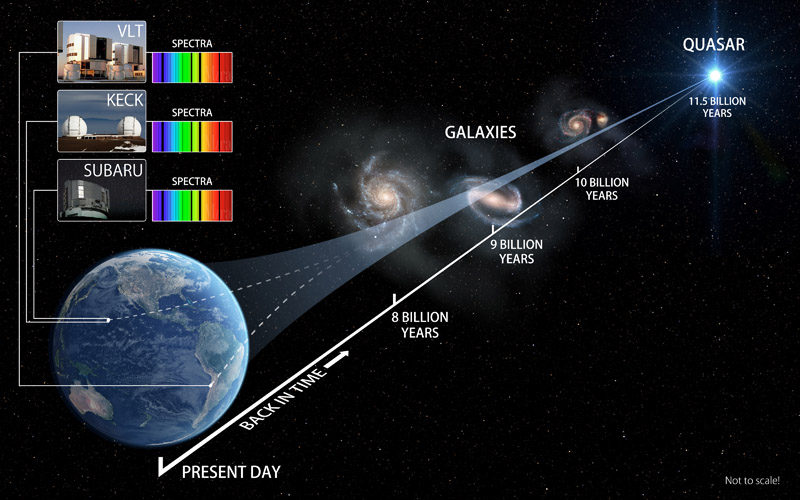THREE EYES ON THE SKY TRACK LAWS OF NATURE 10 BILLION YEARS AGO
Illustration of the light travelling from its source (a quasar) to the telescopes on Earth. On its way the light goes through several galaxies located at different distances thus seen at different times of the universe history. © Swinburne Astronomy Productions
Astronomers have focused the three most powerful optical telescopes in the world on a single point in the sky to test one of Nature's fundamental laws. An international team, including researchers from IAP, observed a quasar - the extremely bright surroundings of a supermassive black hole - using the Very Large Telescope in Chile and the W M Keck Observatory and Subaru Telescope, both in Hawaii.
The quasar light passed through three different galaxies, some 10, 9 and 8 billion years ago, on its way to Earth. These galaxies absorbed a characteristic pattern of colours out of the quasar light, revealing the strength of electromagnetism - one of Nature's four fundamental forces - in the early and distant Universe. The astronomers compare the wavelengths of the same absorbed transitions in the remote universe and on Earth and thus contrain the possible variations of the fundamental constants of physics.
In the recent past years a controversy arose between an anglo-australian group who claimed a variation and an indo-french group who did not confirm this variation. The current experiment was to check the very delicate procedures so that observations using different telescopes give the same answer.
Exquisite data was obtained by an international team gathering all groups involved in this field who won 34 nights of observing time at the Very Large Telescope of the European Southern Observatory in Chile.
At present, no variation is found at the level of precision reached so far. If there is any variation, it must be smaller than 1/10,000 of a percent ! And this is confirmed by the three telescopes.
The publication is led by Tyler Evans, a PhD student at Swinburne University and is accepted for publication in Monthly Notices of the Royal Astronomical Society.
Links (in french)
Actualités du CNRS-INSU
Contact in France :
Patrick Petitjean
Institut d'astrophysique de Paris
ppetitje at iap dot fr
Tel. : +33 1 4432 8150
September 2014

